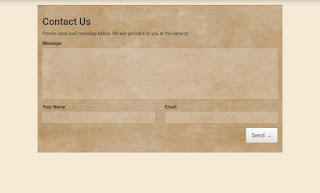Download php contact form with validation and recaptcha | PHP contact form script free download
PHP contact form with recaptcha validation download Free
DOWNLOAD FROM GOOGLE DRIVE
Usage:
- Press the download button above. The zip file contains all the code you need for the form.
- Unzip the file php-contact-form-code
- Open the file named "handler.php"
Look forsendEmailToadd the email addresses to receive the form submissions. - Upload the whole folder to your website
- Open the formpage.html in your browser and test
See a video demo here
The sections below explain the code of this form
The HTML Code
<div class="row">
<div class="col-md-6 col-md-offset-3" id="form_container">
<h2>Contact Us</h2>
<p>
Please send your message below. We will get back to you at the earliest!
</p>
<form role="form" method="post" id="reused_form">
<div class="row">
<div class="col-sm-12 form-group">
<label for="message">
Message:</label>
<textarea class="form-control" type="textarea" id="message" name="message" maxlength="6000" rows="7"></textarea>
</div>
</div>
<div class="row">
<div class="col-sm-6 form-group">
<label for="name">
Your Name:</label>
<input type="text" class="form-control" id="name" name="name" required>
</div>
<div class="col-sm-6 form-group">
<label for="email">
Email:</label>
<input type="email" class="form-control" id="email" name="email" required>
</div>
</div>
<div class="row">
<div class="col-sm-12 form-group">
<button type="submit" class="btn btn-lg btn-default pull-right" >Send →</button>
</div>
</div>
</form>
<div id="success_message" style="width:100%; height:100%; display:none; ">
<h3>Posted your message successfully!</h3>
</div>
<div id="error_message"
style="width:100%; height:100%; display:none; ">
<h3>Error</h3>
Sorry there was an error sending your form.
</div>
</div>
</div>
CSS Styling
The following extra CSS styling is used to make the form look better
<link rel="stylesheet" href="form.css" >
jQuery Form submission handling
<script>
$(function()
{
function after_form_submitted(data)
{
if(data.result == 'success')
{
$('form#reused_form').hide();
$('#success_message').show();
$('#error_message').hide();
}
else
{
$('#error_message').append('<ul></ul>');
jQuery.each(data.errors,function(key,val)
{
$('#error_message ul').append('<li>'+key+':'+val+'</li>');
});
$('#success_message').hide();
$('#error_message').show();
//reverse the response on the button
$('button[type="button"]', $form).each(function()
{
$btn = $(this);
label = $btn.prop('orig_label');
if(label)
{
$btn.prop('type','submit' );
$btn.text(label);
$btn.prop('orig_label','');
}
});
}//else
}
$('#reused_form').submit(function(e)
{
e.preventDefault();
$form = $(this);
//show some response on the button
$('button[type="submit"]', $form).each(function()
{
$btn = $(this);
$btn.prop('type','button' );
$btn.prop('orig_label',$btn.text());
$btn.text('Sending ...');
});
$.ajax({
type: "POST",
url: 'handler.php',
data: $form.serialize(),
success: after_form_submitted,
dataType: 'json'
});
});
});
</script>
Form Validations
HTML5 validations are used. For example, the Name and Email fields have 'required' validation and the email field is of input type 'email'.
<input type="email" class="form-control" id="email" name="email" required>
<textarea name="Message" maxlength="6000" required></textarea>
You can customize those validations to fit your needs
Server Side Handling
Every form requires a server side script to collect the form data and do the processing like send emails, save to database etc. This form comes with a PHP script to handle the form submissions. PHP is widely supported server side scripting platform.When the form is submitted, the javascript form submission event handler above collects the form data and sends it to the server side script.
The serverside script entry point is handler.php (see in your downloaded zip file). The script uses a library called FormHandler, which inturn, uses other libraries.
Here is the code of the handler.php
<?php
ini_set('display_errors', 1);
ini_set('display_startup_errors', 1);
error_reporting(E_ALL);
/*
Tested working with PHP5.4 and above (including PHP 7 )
*/
require_once './vendor/autoload.php';
use FormGuide\Handlx\FormHandler;
$pp = new FormHandler();
$validator = $pp->getValidator();
$validator->fields(['name','email'])->areRequired()->maxLength(50);
$validator->field('email')->isEmail();
$validator->field('message')->maxLength(6000);
$pp->sendEmailTo('someone@gmail.com'); // ← Your email here
echo $pp->process($_POST);
$fh->sendEmailTo(['someone@gmail.com', 'someone.else@gmail.com']);
Server Side Form Validations
Server side form validations are essential for any form. You can't trust data sent to a form processing script.For this form, the server side form validations are done using this PHPFormValidation library. See the documentation to add or update the validations.










